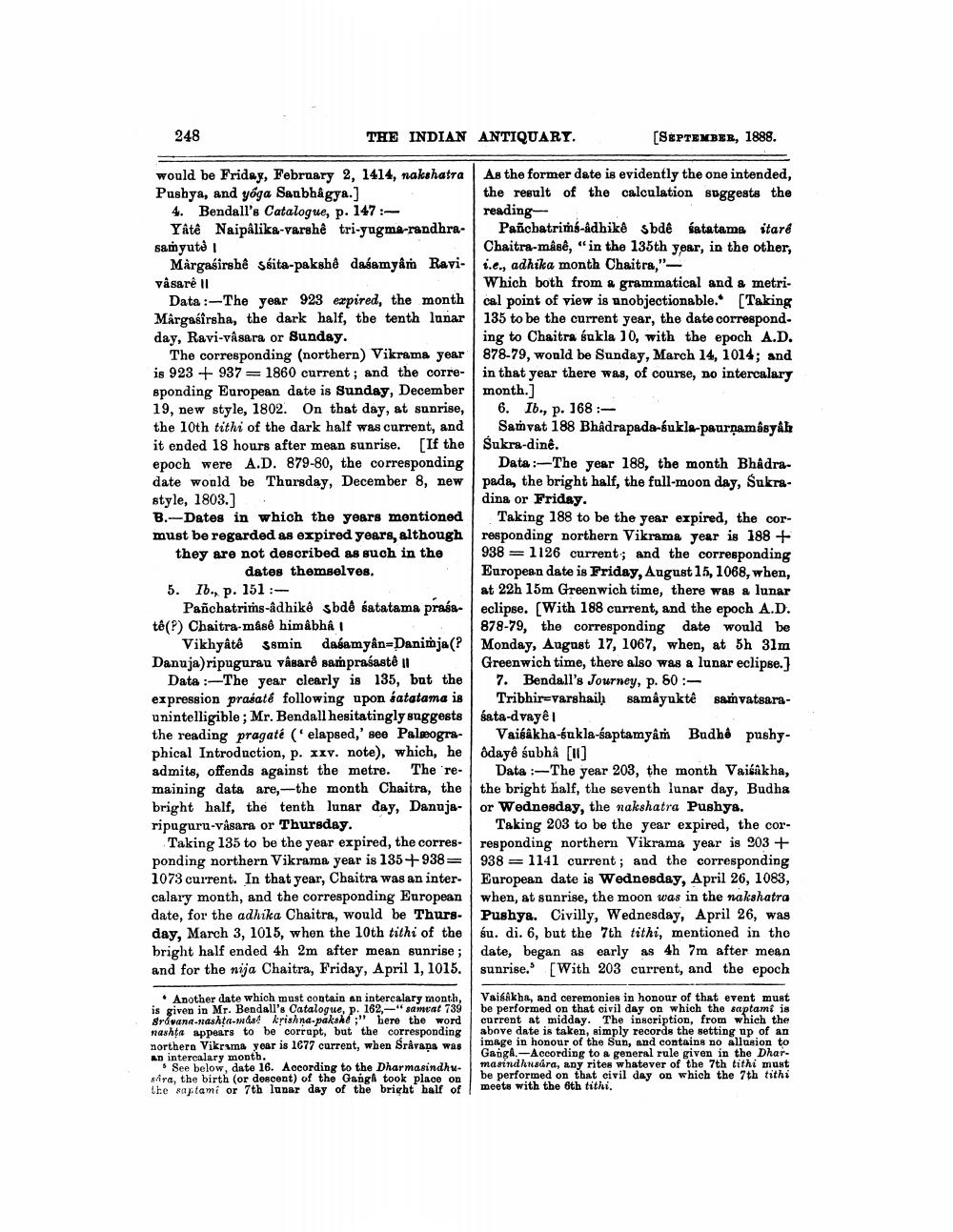________________
THE INDIAN ANTIQUARY.
[SEPTEMBER, 1888.
would be Friday, February 2, 1414, nakshatra As the former date is evidently the one intended, Pushya, and yoga Saubhagya.] the result of the calculation suggests the reading
4. Bendall's Catalogue, p. 147:
248
Yatê Naipalika-varshê tri-yugma-randhrasamyuta I
Margasirshê ssita-pakshê dasamyâm Ravivasarė II
Data:-The year 923 expired, the month Mârgasîrsha, the dark half, the tenth lunar day, Ravi-vâsara or Sunday.
The corresponding (northern) Vikrama year is 923937=1860 current; and the corresponding European date is Sunday, December 19, new style, 1802. On that day, at sunrise, the 10th tithi of the dark half was current, and it ended 18 hours after mean sunrise. [If the epoch were A.D. 879-80, the corresponding date would be Thursday, December 8, new style, 1803.]
Vikhyâte ssmin dasamyân-Danimja(? Danuja)ripugurau vâsarê samprasastê ||
Data: The year clearly is 135, but the expression prasaté following upon satatama is unintelligible; Mr. Bendall hesitatingly suggests the reading pragaté ( elapsed,' see Paleographical Introduction, p. xxv. note), which, he admits, offends against the metre. The remaining data are, the month Chaitra, the bright half, the tenth lunar day, Danujaripuguru-vâsara or Thursday.
Taking 135 to be the year expired, the corresponding northern Vikrama year is 135+938 1073 current. In that year, Chaitra was an intercalary month, and the corresponding European date, for the adhika Chaitra, would be Thursday, March 3, 1015, when the 10th tithi of the bright half ended 4h 2m after mean sunrise; and for the nija Chaitra, Friday, April 1, 1015.
Pañchatrims-adhikê sbdê satatama itaré Chaitra-masê, "in the 135th year, in the other, i.e., adhika month Chaitra,"
Data:-The year 188, the month Bhadrapada, the bright half, the full-moon day, Sukradina or Friday.
Taking 188 to be the year expired, the corresponding northern Vikrama year is 188 + 9381126 current; and the corresponding European date is Friday, August 15, 1068, when, at 22h 15m Greenwich time, there was a lunar Panchatrims-adhikê sbdê satatama prasa- eclipse. [With 188 current, and the epoch A.D. tê(?) Chaitra-mâsê himâbhâ
B.-Dates in which the years mentioned must be regarded as expired years, although they are not described as such in the dates themselves. 5. Ib., p. 151:
878-79, the corresponding date would be Monday, August 17, 1067, when, at 5h 31m Greenwich time, there also was a lunar eclipse.] 7. Bendall's Journey, p. 80:Tribhir varshail samâyuktê samvatsarasata-dvayê |
Another date which must contain an intercalary month, is given in Mr. Bendall's Catalogue, p. 162,-" samvat 739 Bravana-nashta-más krishna-pakshe;" here the word nashta appears to be corrupt, but the corresponding northern Vikrama year is 1677 current, when Śravana was an intercalary month.
See below, date 16. According to the Dharmasindhusira, the birth (or descent) of the Gangå took place on the saptami or 7th lunar day of the bright half of
Which both from a grammatical and a metrical point of view is unobjectionable. [Taking 135 to be the current year, the date correspond. ing to Chaitra sukla 10, with the epoch A.D. 878-79, would be Sunday, March 14, 1014; and in that year there was, of course, no intercalary month.]
6. Ib., p. 168
Samvat 188 Bhadrapada-sukla-paurṇamasyah Sukra-dinê.
Vaisakha-śukla-saptamyâm Budhe pushyôdayê subha [1]
Data:-The year 203, the month Vaisakha, the bright half, the seventh lunar day, Budha or Wednesday, the nakshatra Pushys.
Taking 203 to be the year expired, the corresponding northern Vikrama year is 203 + 9381141 current; and the corresponding European date is Wednesday, April 26, 1083, when, at sunrise, the moon was in the nakshatra Pushya. Civilly, Wednesday, April 26, was śu. di. 6, but the 7th tithi, mentioned in the date, began as early as 4h 7m after mean sunrise. [With 203 current, and the epoch
Vaisakha, and ceremonies in honour of that event must be performed on that civil day on which the saptami is current at midday. The inscription, from which the above date is taken, simply records the setting up of an image in honour of the Sun, and contains no allusion to Ganga. According to a general rule given in the Dharmasindhusára, any rites whatever of the 7th tithi must be performed on that civil day on which the 7th tithi meets with the 6th tithi.




